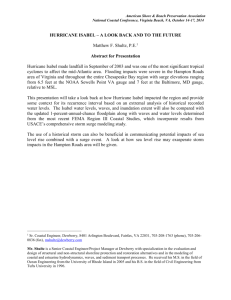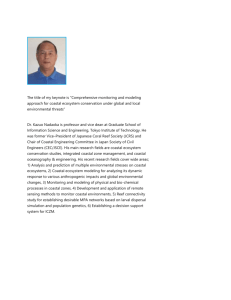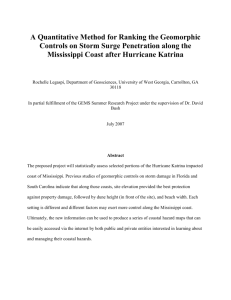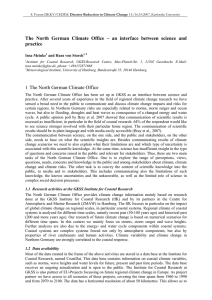Evaluation of Methodology to Assess Coastal System
advertisement
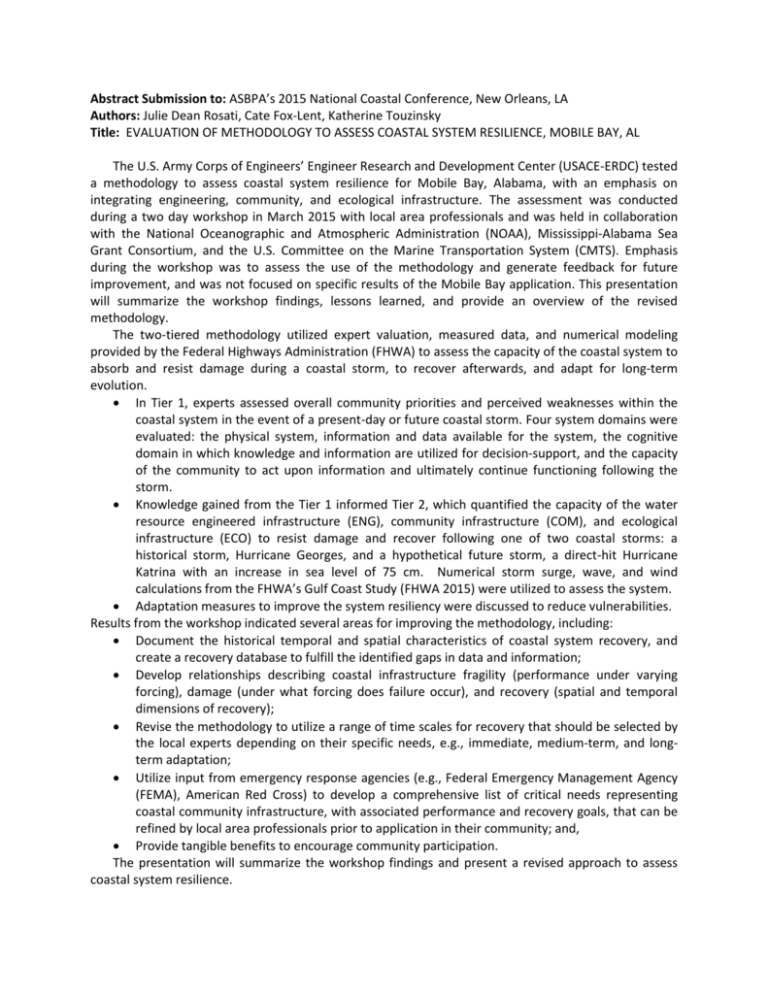
Abstract Submission to: ASBPA’s 2015 National Coastal Conference, New Orleans, LA Authors: Julie Dean Rosati, Cate Fox-Lent, Katherine Touzinsky Title: EVALUATION OF METHODOLOGY TO ASSESS COASTAL SYSTEM RESILIENCE, MOBILE BAY, AL The U.S. Army Corps of Engineers’ Engineer Research and Development Center (USACE-ERDC) tested a methodology to assess coastal system resilience for Mobile Bay, Alabama, with an emphasis on integrating engineering, community, and ecological infrastructure. The assessment was conducted during a two day workshop in March 2015 with local area professionals and was held in collaboration with the National Oceanographic and Atmospheric Administration (NOAA), Mississippi-Alabama Sea Grant Consortium, and the U.S. Committee on the Marine Transportation System (CMTS). Emphasis during the workshop was to assess the use of the methodology and generate feedback for future improvement, and was not focused on specific results of the Mobile Bay application. This presentation will summarize the workshop findings, lessons learned, and provide an overview of the revised methodology. The two-tiered methodology utilized expert valuation, measured data, and numerical modeling provided by the Federal Highways Administration (FHWA) to assess the capacity of the coastal system to absorb and resist damage during a coastal storm, to recover afterwards, and adapt for long-term evolution. In Tier 1, experts assessed overall community priorities and perceived weaknesses within the coastal system in the event of a present-day or future coastal storm. Four system domains were evaluated: the physical system, information and data available for the system, the cognitive domain in which knowledge and information are utilized for decision-support, and the capacity of the community to act upon information and ultimately continue functioning following the storm. Knowledge gained from the Tier 1 informed Tier 2, which quantified the capacity of the water resource engineered infrastructure (ENG), community infrastructure (COM), and ecological infrastructure (ECO) to resist damage and recover following one of two coastal storms: a historical storm, Hurricane Georges, and a hypothetical future storm, a direct-hit Hurricane Katrina with an increase in sea level of 75 cm. Numerical storm surge, wave, and wind calculations from the FHWA’s Gulf Coast Study (FHWA 2015) were utilized to assess the system. Adaptation measures to improve the system resiliency were discussed to reduce vulnerabilities. Results from the workshop indicated several areas for improving the methodology, including: Document the historical temporal and spatial characteristics of coastal system recovery, and create a recovery database to fulfill the identified gaps in data and information; Develop relationships describing coastal infrastructure fragility (performance under varying forcing), damage (under what forcing does failure occur), and recovery (spatial and temporal dimensions of recovery); Revise the methodology to utilize a range of time scales for recovery that should be selected by the local experts depending on their specific needs, e.g., immediate, medium-term, and longterm adaptation; Utilize input from emergency response agencies (e.g., Federal Emergency Management Agency (FEMA), American Red Cross) to develop a comprehensive list of critical needs representing coastal community infrastructure, with associated performance and recovery goals, that can be refined by local area professionals prior to application in their community; and, Provide tangible benefits to encourage community participation. The presentation will summarize the workshop findings and present a revised approach to assess coastal system resilience.





